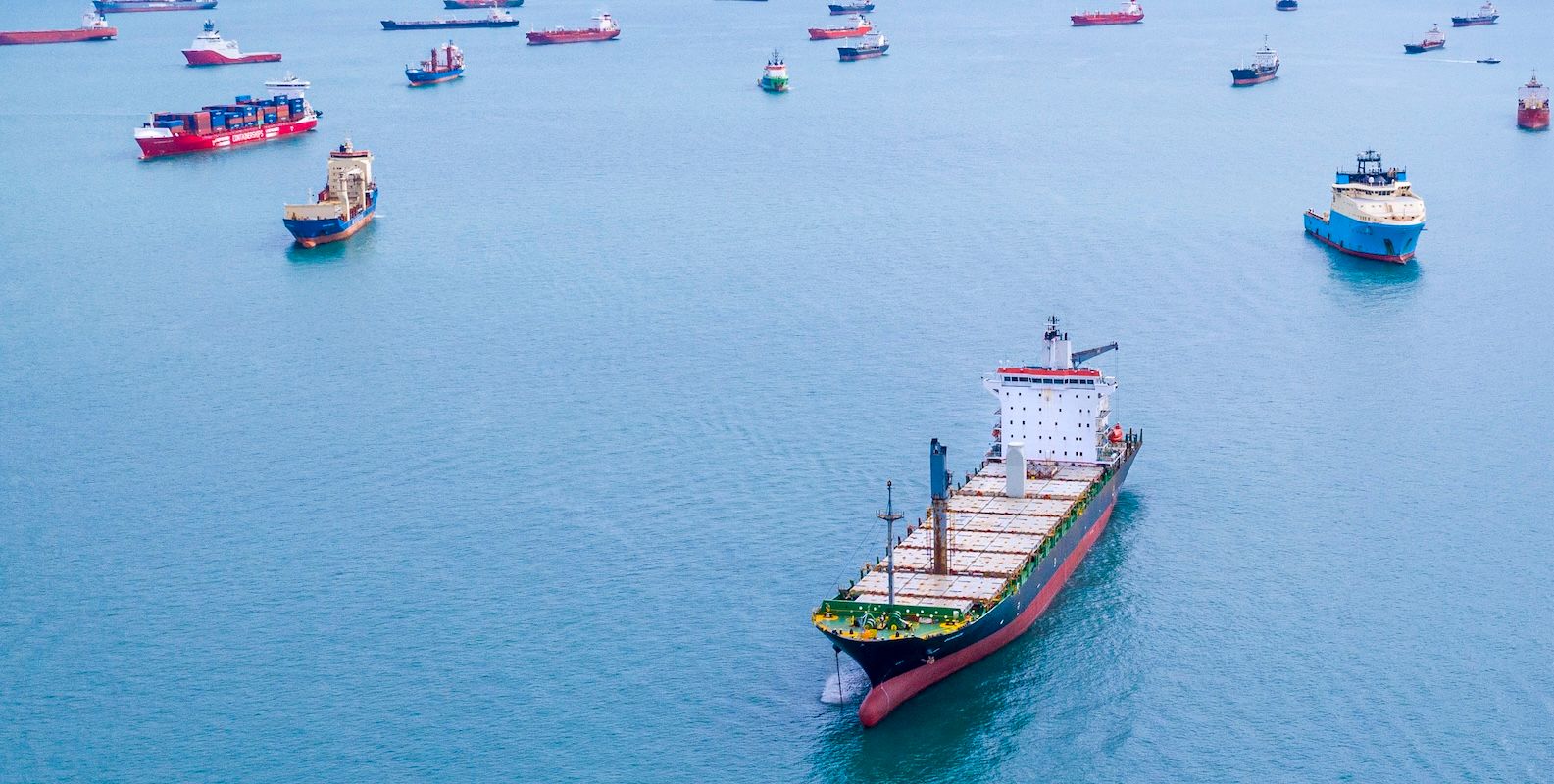
Global Logistics Update
U.S. and China Trade War Escalates; Electronics Get a Temporary Reprieve
North America vessel dwell times and other updates from the global supply chain | May 17, 2023
Global Logistics Update: April 17, 2025

Trends to Watch
Talking Tariffs: The U.S.-China trade dispute escalated over the past two weeks, with tariff rates on both sides reaching historic highs. Meanwhile, U.S. Customs and Border Protection (CBP) has issued a temporary exemption for electronics—offering short-term relief to technology products.
We launched the Flexport Tariff Simulator. Estimate and forecast tariffs and landed costs for each shipment, all based on real-time data and the latest rates and regulations.
- Temporarily Exemption for a List of 20 Products (including semi-conductors) from IEEPA Reciprocal Tariffs:
On April 11, POTUS issued a Presidential Memorandum clarifying the meaning of “semiconductors” that are exempted from IEEPA tariff actions covered by Executive Order (EO) 14257 (April 2, 2025), as amended by EO 14259 (April 8, 2025) and EO 14266 (April 9, 2025), imposing 10% reciprocal tariffs on goods from most countries and 125% reciprocal tariffs on goods from China.
The product exclusions are detailed in Annex II of EO 14257, which does not effectively incorporate all Harmonized Tariff Schedule of the U.S. (“HTSUS”) codes that the April 11 Memorandum defines as “semiconductor” products. The Memorandum ordered CBP to update the HTSUS to incorporate product exclusions for a list of 20 HTSUS Headings, Subheadings, and 10-digit classification codes, covering, e.g., smartphones, computers, semiconductors, solar cells.
These exemptions apply retroactively to the effective date of these tariff measures on April 5, 2025. Importers must reference HTS code 9903.01.32 on the customs entry declaration and submit corrections to entries already filed within 10 days of cargo release. President Trump indicated these exemptions may be curtailed if the new national security investigation into semiconductors leads to additional tariffs. Products from China continue to be subject to 20% IEEPA fentanyl tariffs.
- China Retaliates with 125% Tariffs on U.S. Goods: In response to U.S. tariff hikes, China increased tariffs on U.S. goods from 84% to 125%, effective April 12. China's Ministry of Finance stated U.S. goods are "no longer market-viable" under current tariff levels and indicated it has no intention of enacting further retaliatory measures on U.S. products unless the U.S. takes further tariff action.
- U.S. Tariffs on Chinese Goods Reach 145%: The White House clarified total IEEPA tariffs on Chinese goods amount to 145%, combining the 125% IEEPA reciprocal tariffs with an existing 20% levy under the IEEPA fentanyl action.
Ocean: Trans-Pacific Eastbound (TPEB)
- Capacity and Demand:
- China Tariff Impact: The tariffs on goods from China are negatively impacting booking volumes, leading to cancellations. This is a new trend we are continuing to monitor.
- Southeast Asia Demand: Booking volumes from Southeast Asia have returned to normal levels but are not compensating for the lost volume from China. It will take several more weeks to gain a clearer understanding of the full impact of the China tariffs on overall demand, but as of now, we are not seeing volumes from Southeast Asia make up the difference from China impacted volume.
- Significant Capacity Reductions: Carriers are actively reducing capacity through increased blank sailings and vessel downsizes, aiming for 60-70% capacity in May. Carriers are reviewing their capacity and vessel deployment plans and are likely to implement further reductions in response to the China tariff impacts.
- Equipment: Shipping container availability is generally good at most origin ports. There are some localized equipment shortages in Southeast Asia, but these are not considered major concerns at this time.
- Freight Rates:
- Floating Rates: Floating freight rates have been extended until the end of April for both Southeast Asia and China origins. This suggests that carriers are not seeing the anticipated strong increase in Southeast Asia volume that would typically lead to rate hikes. Mitigation measures are in place for both regions.
- Fixed Rates: Fixed freight rates are currently being held steady, with no significant movements observed. These rates are expected to be finalized by the end of April, coinciding with the completion of the contract season.
Ocean: Far East Westbound (FEWB)
- Capacity and Demand: Late April demand remains flat with no significant increase. The upcoming Labor Day holiday is expected to further soften market activity.No noticeable cargo diversion from US-bound shipments to EU trade has materialized yet, despite the impact of new U.S. tariffs. Carriers are reallocating capacity from the Transpacific to North Europe routes due to weaker U.S. demand caused by tariff adjustments. This shift is exacerbating oversupply conditions in the FEWB trade, likely extending into early May. The additional capacity is limiting the potential upward momentum in freight rates.
- Freight Rates: The SCFI index has recorded a minor increase for the sixth consecutive week, indicating a largely stable rate environment in the near term. Given market uncertainties, we recommend securing bookings early to mitigate potential risks from future cargo surges or capacity constraints.
Ocean: Trans-Atlantic Westbound (TAWB)
- Capacity and Demand: Blank sailing numbers have dramatically decreased. The blank sailings are mainly on East Mediterranean services. There is congestion in the Port of Piraeus, Mersin and Valencia in the Mediterranean and in Hamburg , Antwerp and Rotterdam in North Europe which is affecting the schedule.
- Equipment: Equipment shortages persist in parts of Central Europe, particularly in Austria, Slovakia, Switzerland, Hungary, and Southern/Eastern Germany. Carrier haulage is recommended for these origins. No major issues in the other ports and regions.
- Freight Rates: As a result of the postponement of the U.S. tariffs in the EU, carriers are anticipating a peak in demand for the next 90 days. Some carriers already implemented PSS ex North Europe from May 13th. In the West Mediterranean, the PSS that was planned for April will be applied in the beginning of May. In the East Mediterranean carriers are implementing PSS and GRIs from the beginning of May as they anticipate the demand to increase from Turkey.
Ocean: Indian Subcontinent to North America
- Capacity and Demand: North West India to the U.S. East Coast is experiencing ~50% sailing cut with multiple carriers blanking in Week 16. Further capacity challenges should be expected on this lane as carriers are downsizing vessels in their services in upcoming weeks. Downsizing vessels will cause some short term capacity challenges, but the overall goal is to provide more consistent weekly sailings with smaller vessels versus blanking sailings on a near monthly basis with larger vessels.
- Freight Rates: Due to capacity challenges, rates ex ISC to USEC are on the rise. $400-$500 per 40' increase are being seen for 2H April. GRI/PSS are already announced for May 1st and May 11th and are expected to stick.
Air Freight Update (Week 14: March 31 - April 6, 2025):
- Demand drops sharply across the board — but rates stay resilient
- Global air cargo tonnages fell -7% week on week (WoW) in week 14 (March 31–April 6), driven by Eid-related slowdowns and growing trade uncertainty.
- Despite the drop in demand, average global rates increased +2% WoW and are +3% higher year on year (YoY) — signaling continued tight capacity or strong rate discipline by carriers.
- MESA and Africa see steepest tonnage declines
- Week 14 saw double-digit WoW drops in volume from Middle East & South Asia (-24%) and Africa (-21%), with Pakistan, Bangladesh, Egypt, and UAE showing the steepest declines (up to -50% WoW), linked to Eid-al-Fitr.
- Asia-Pacific: Rates up despite softening demand
- Demand ex-Asia Pacific fell -7% WoW, with key lanes like China/Hong Kong to LAX down -5% WoW.
- Yet, pricing ex-Asia Pacific rose +4% WoW, and spot rates jumped +5% to $3.94/kg, showing rate strength even as volumes soften.
- U.S.-China tariffs starting to bite — more impact expected
- The first week-on-week tonnage decline (-1%) ex-China/Hong Kong to the U.S. since January suggests the start of tariff-related slowdown.
- With new U.S. tariffs effective April 9, more pronounced volume and rate shifts are expected next week — customers may want to secure capacity early or reassess routing strategies.
Source: worldacd.com
Please reach out to your account representative for details on any impacts to your shipments.
North America Vessel Dwell Times

Upcoming Webinars
Tariff Trends 2025: Expert Insights on the New U.S. Customs Landscape
Wednesday, April 23 @ 8:00 am PT / 11:00 am ET / 16:00 BST / 17:00 CEST
The Control Tower Advantage: Visibility, Agility, and Smarter Decisions
Tuesday, April 29 @ 16:00 CEST / 15:00 BST / 7:00 am PT / 10:00 am ET
Ocean Timeliness Indicator
This week, the Flexport OTI for China to the U.S. West Coast and China to North Europe showed an uptick, while China to the U.S. East Coast decreased.
Week to April 14, 2025
The Ocean Timeliness Indicator (OTI) for China to the U.S. West Coast and China to North Europe has shown a small uptick, respectively rising from 32.5 to 33 days and 75 to 77 days. Meanwhile, China to the U.S. East Coast fell sharply, decreasing from 68 to 58.5 days.

About the Author






